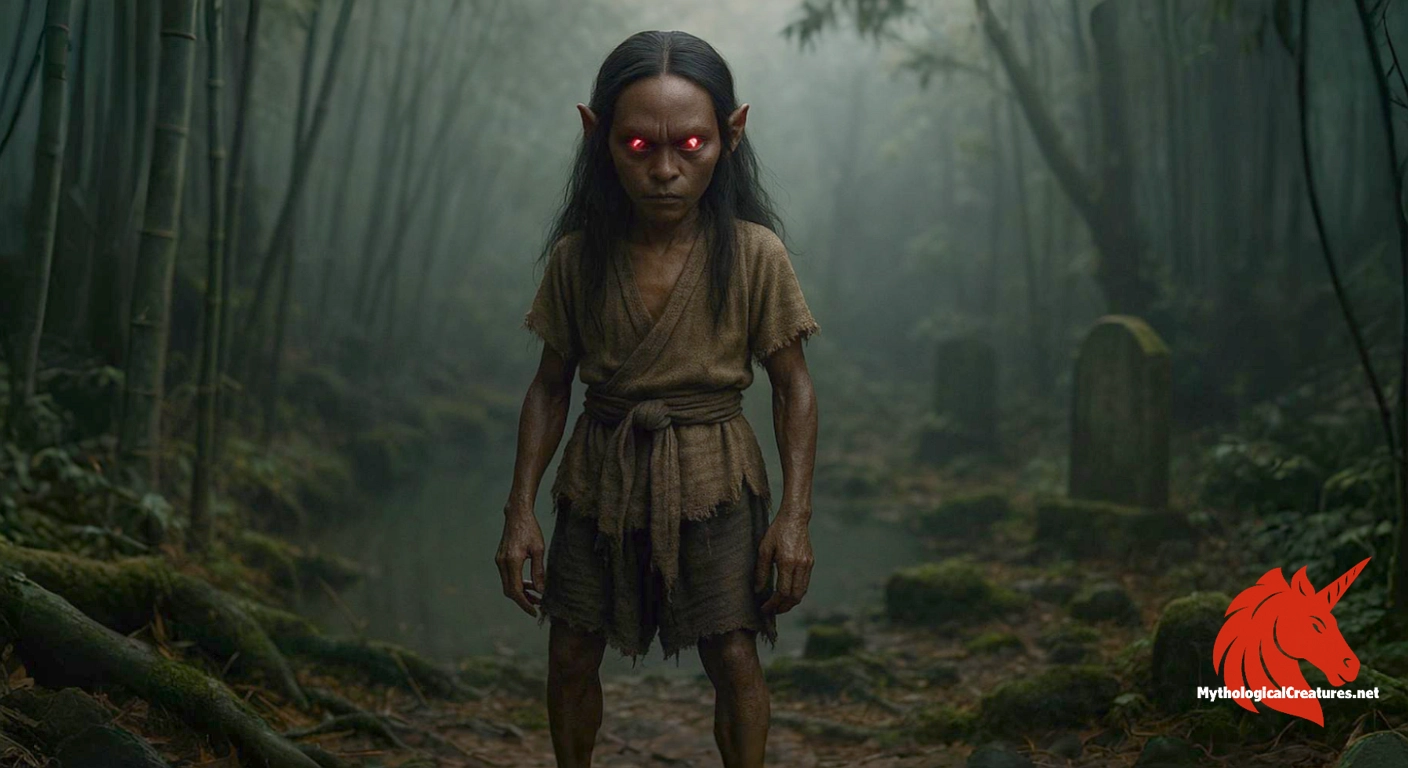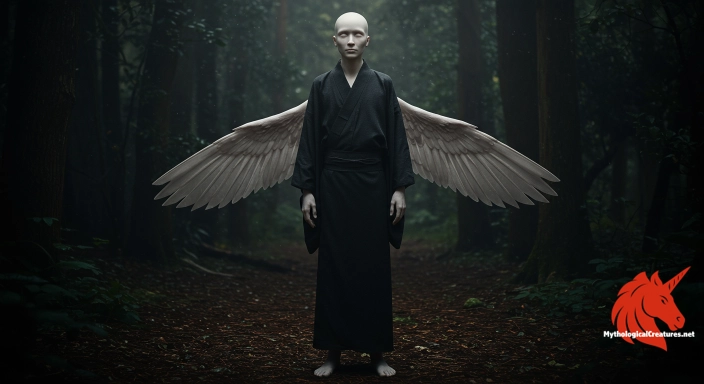Wangliang: Wangliang is a malevolent spirit from Chinese folklore known for its diverse and unsettling manifestations.

Wangliang
Wangliang - The wangliang serves as a cautionary figure in Chinese myth, embodying the unpredictable and multifaceted nature of malevolent supernatural forces.
Origins & First Encounters
The wangliang has long been recognised as a uniquely multifaceted spirit in Chinese folklore, its presence woven deeply into ancient cultural narratives. Its origins are rooted in early animistic practices, with legends evolving over centuries to reflect the complex interplay between nature and the supernatural. Early attestations of this creature appear in diverse oral traditions and manuscripts, where it is variously portrayed as both a wilderness inhabitant and a portent of misfortune. It has been associated with elements of water, fever, and graveyard hauntings, showcasing its ability to embody multiple forms and cultural fears. The myth of the wangliang reflects a worldview in which the spirit realm is intimately connected to the everyday, and where malevolent forces serve as cautionary presences. Its narrative has been enriched by a mosaic of regional stories, each contributing to its enigmatic identity. The creature’s dual nature—combining elements of menace and mysterious allure—has allowed it to persist as a symbolic figure across generations. Over time, the wangliang has come to represent the unpredictable forces that challenge the boundaries between life and death, inviting both fear and fascination.
Source Texts & Tale Variants
The primary narrative of the wangliang is documented in an array of ancient texts, folk compilations, and local accounts that span a broad historical continuum. Early literary references, though scarce and fragmentary, intertwine with oral histories that have been passed down through generations. Various manuscripts from Daoist and Buddhist traditions hint at its resemblance to other ominous spirits, such as the kui and the yu, thereby situating it within a larger pantheon of supernatural beings. Folktale collections and regional gazetteers have further enriched its lore, offering multiple story variants that underscore its mutable identity. In some accounts, the wangliang is described as a ghost haunting graveyards, while in others it roams untamed wildernesses and misty waterways. The creature is also known by alternative names like wangxiang and fangliang, each carrying unique connotations and reflective of local dialects. Diverse narrative streams have contributed to a layered mythos where the creature assumes different roles depending on the community. These varied sources, both written and oral, illustrate the enduring power of folklore to adapt and absorb local social and environmental influences.
Form & Powers
Descriptions of the wangliang’s form are as diverse as the tales that recount its haunting exploits. In one vivid portrayal, it appears as a three-year-old child with brown, earthen skin that belies the sinister nature lurking beneath. Its bright red eyes and unusually long ears create an unsettling contrast against its almost beautiful, flowing hair. In alternative depictions, the creature adopts attributes reminiscent of a water spirit, with sinuous, serpentine qualities and subtle, scale-like textures that hint at a connection with the legendary Chinese dragon. Such varied imagery captures a being that is at once innocent and malevolent, blurring the boundaries between a benign child and a ferocious demon. The mutable physicality of the wangliang is emphasised by legends that describe its form as shifting, taking on ephemeral qualities that defy easy categorisation. Some portrayals accentuate its ghostly translucence, suggesting that its appearance is as fleeting as a shadow over water. This fusion of delicate beauty and latent horror offers a striking illustration of the creature’s inherent duality.
Regional Faces
Regional traditions have further diversified the legend of the wangliang, imbuing it with distinctive local characteristics and contextual interpretations. In certain southern regions, the creature is primarily depicted as a water spirit, often seen lurking near misty lakes or meandering rivers. In contrast, northern accounts tend to emphasise its role as a wild, untamed ghost, roaming isolated forests and barren landscapes. Local narratives sometimes recast the wangliang as a fever demon, a malevolent force believed to be responsible for sudden bouts of illness in vulnerable communities. In some rural areas, it is associated with ancient burial sites, where it is known by names like wangxiang or fangliang, reflecting deeply rooted local dialects. Such regional variations reveal how fear and natural phenomena were interwoven in traditional storytelling to explain misfortune and disease. Even within the same province, differences in narrative detail reflect the unique environmental features and cultural nuances of individual communities. This geographical adaptability has cemented the wangliang’s place as a culturally resonant symbol, one that is continually reshaped by local beliefs and circumstances.
Cultural Parallels
When examined alongside other mythological beings, the wangliang occupies an intriguing space that bridges several cultural traditions. Its multifaceted portrayal as a malevolent, shape-shifting spirit invites comparisons with entities found in neighboring East Asian lore, where ambiguous supernatural forces walk the line between benevolence and peril. Elements of its narrative echo the Japanese tradition of yōkai, whose many forms can be both beguiling and dangerous. Similarly, European folklore offers parallels in creatures that embody deceptive innocence combined with latent cruelty—a theme that resonates with the wangliang’s dualistic nature. The fluidity of its character, shifting between a lovable childlike veneer and a fearsome demon, is a motif found in various mythic traditions around the world. Such comparative analysis highlights a universal human response to unexplained phenomena and the boundary between the natural and the supernatural. The shared themes, whether in Eastern, European, or other mythologies, underscore the timeless nature of the struggle against unseen and unpredictable forces. This cross-cultural dialogue enriches our understanding of how different societies have historically dealt with concepts of danger and the uncanny.
Legacy & Modern Evolution
The evolution of the wangliang myth mirrors the broader shifts in Chinese cultural and spiritual narratives over countless generations. Initially embedded in archaic folklore, its story was passed down through oral traditions and local texts, where it absorbed numerous layers of meaning. As dynasties rose and fell and societal values transformed, the creature’s portrayal gradually evolved to reflect both lingering ancient beliefs and the emerging complexities of urban life. In modern times, reinterpretations of the wangliang have placed it at the centre of contemporary horror literature, film, and art, often highlighting its ambiguous morality and shifting appearance. Modern storytellers frequently cast the creature as a tragic figure—a victim of old superstitions thrust into a new world where the lines between innocence and malice are blurred. Its image now serves as a potent metaphor for forces beyond human control, mirroring current societal anxieties. As digital media and popular culture continue to reimagine classic folklore, the wangliang endures as both a cautionary emblem and a source of artistic inspiration. Its evolving legacy testifies to the dynamic nature of myth, capable of resonating with audiences across time and cultural shifts, ensuring that this enigmatic spirit remains alive in the modern imagination.
Interesting Fact
An intriguing aspect of the wangliang is its ability to manifest in entirely different forms—ranging from a water spirit to a child-like demon—challenging simple classification and reflecting the multifaceted nature of evil in Chinese folklore.
Quick Creature Info
Associations:
Our Mythic Legendary Rating:

Also Sometimes Known As:
Habitat:
Supernatural Powers:
Physical Attributes:
Abilities:
Behavior:
Lore:
Related Creatures, Tales or Lore
- KKui
- CChinese Dragon
- YYu (poisonous three‐legged turtle)
References
Discover Another Mythical Legend You May Not Have Heard Of?
Uncover the mysteries of ancient folklore and expand your knowledge of legendary beings from cultures around the world.
Dare to Meet the Noppera-bō....
Curated by the Mythological Creatures Team (rev. May 2025)
